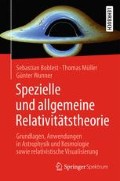Zusammenfassung
Weiße Zwerge sind das Entstadium der Entwicklung massearmer Sterne. Diese etwa planetengroßen Objekte sind durch sehr hohe Materiedichten gekennzeichnet. Wir besprechen in diesem Kapitel die grundlegenden Eigenschaften weißer Zwerge und den wichtigen Supernovatyp Ia, bei dem ein weißer Zwerg explodiert.
Access this chapter
Tax calculation will be finalised at checkout
Purchases are for personal use only
Notes
- 1.
Henry Norris Russell, 1877–1957, amerikanischer Astronom. Nach ihm ist auch das Hertzsprung-Russell-Diagramm mitbenannt (s. Kap. 22).
- 2.
Subrahmanyan Chandrasekhar, 1910–1995. Amerikanischer Astrophysiker. Physik-Nobelpreis 1983 für seine Arbeiten zur Sternentwicklung.
- 3.
Lew Dawidowitsch Landau, 1908–1968, sowjetischer Physiker, Nobelpreis 1962.
- 4.
Werner Karl Heisenberg, 1901–1976, deutscher Physiker, Nobelpreis 1932.
- 5.
Edwin Ernest Salpeter, 1924–2008, US-amerikanischer Astrophysiker österreichischer Abstammung.
- 6.
Georg Simon Ohm, 1789–1854, deutscher Physiker.
- 7.
Hannes Olof Gösta Alfvén, 1908–1995, schwedischer Physiker, Nobelpreis 1970.
Literatur
Althaus, L.G., Córsico, A.H., Isern, J., García-Berro, E.: Evolutionary and pulsational properties of white dwarf stars. Astron. Astrophys. Rev. 18(4), 471–566 (2010)
Das, U., Mukhopadhyay, B.: New mass limit for white dwarfs: Super-Chandrasekhar type Ia supernova as a new standard candle. Phys. Rev. Lett. 110, 071102 (2013)
Hamada, T., Salpeter, E.E.: Models for zero-temperature stars. Astrophys. J. 134, 683–698 (1961)
Presseveröffentlichung zur Beobachtung von Sirius B mit dem: Hubble-Teleskop. http://hubblesite.org/newscenter/archive/releases/2005/36/text/
Jordan, S., et al.: The fraction of DA white dwarfs with kilo-Gauss magnetic fields. Astron. Astrophys. 462(3), 1097–1101 (2007)
Kawaler, S.D.: White dwarf rotation: observations and theory. In: Stellar Rotation Proceedings IAU Symposium, S. 215. (2003)
Kemp, J.C., Swedlund, J.B., Landstreet, J.D., Angel, J.R.P.: Discovery of circularly polarized light from a white dwarf. Astrophys. J. 161, L77–L79 (1970)
Kepler, S.O., et al.: White dwarf mass distribution in the SDSS. Mon. Not. R. Astron. Soc. 375, 1315–1324 (2007)
Kilic, M., Prieto, C.A., Brown, W.R., Koester, D.: The lowest mass white dwarf. Astrophys. J. 660(2), 1451–1461 (2007)
Koester, D., Chanmugam, G.: Physics of white dwarf stars. Rep. Prog. Phys. 53(7), 837 (1990)
Landau, L.D.: On the theory of stars. Phys. Z. Sowjet. 1, 285 (1932)
Liebert, J., Bergeron, P., Holberg, J.B.: The true incidence of magnetism among field white dwarfs. Astronom. J. 125(1), 348 (2003)
Homepage der Nearby Supernova Factory: http://snfactory.lbl.gov
Nomoto, K., Iwamoto, K., Kishimoto, N.: Type Ia supernovae: Their origin and possible applications in cosmology. Science 276, 1378–1382 (1997)
Nugent, P.E., et al.: Supernova SN 2011fe from an exploding carbon–oxygen white dwarf star. Nature 480, 344–347 (2011)
Provencal, J.L., Shipman, H.L., Høg, E., Thejll, P.: Testing the white dwarf mass-radius relation with hipparcos. Astrophys. J. 494(2), 759 (1998)
Russel, H.N.: Relations between the spectra and other characteristics of the stars. Popular Astronomy 22, 275–294 (1914)
Salpeter, E.E.: Energy and pressure of a zero-temperature plasma. Astrophys. J. 134, 669–682 (1961)
Schimeczek, C., Wunner, G.: Atomic data for the spectral analysis of magnetic DA white dwarfs in the SDSS. Astrophys. J. Supp. Series 212(2), 26 (2014)
Shapiro, S.L., Teukolsky, S.A.: Black holes, white dwarfs, and neutron stars: The physics of compact objects. Wiley-Interscience, New York (1983)
Woosley, S.E., Heger, A., Weaver, T.A.: The evolution and explosion of massive stars. Rev. Mod. Phys. 74, 1015–1071 (2002)
Author information
Authors and Affiliations
Corresponding author
Rights and permissions
Copyright information
© 2016 Springer-Verlag Berlin Heidelberg
About this chapter
Cite this chapter
Boblest, S., Müller, T., Wunner, G. (2016). Weiße Zwerge. In: Spezielle und allgemeine Relativitätstheorie. Springer Spektrum, Berlin, Heidelberg. https://doi.org/10.1007/978-3-662-47767-0_20
Download citation
DOI: https://doi.org/10.1007/978-3-662-47767-0_20
Published:
Publisher Name: Springer Spektrum, Berlin, Heidelberg
Print ISBN: 978-3-662-47766-3
Online ISBN: 978-3-662-47767-0
eBook Packages: Life Science and Basic Disciplines (German Language)

